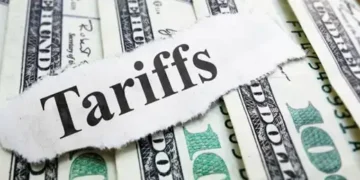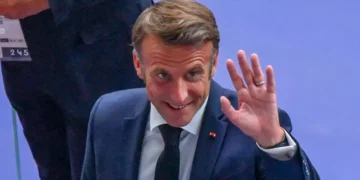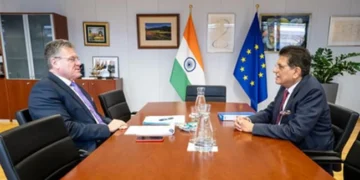Blitz Bureau
NEW DELHI: India’s financial markets and export sectors are navigating their most turbulent phase in recent months, with steep US tariffs on Indian exports triggering record foreign outflows and exposing long-standing distortions in the country’s trade and manufacturing ecosystem. The twin shocks of external pressure and internal inefficiencies have left investors wary and exporters scrambling for alternatives.
Biggest FPI Sell-off in Six Months
Foreign Portfolio Investors (FPIs) withdrew nearly ₹34,993 crore, or about $4 billion, from Indian equities in August, marking the sharpest sell-off in six months and nearly double July’s outflow of ₹17,741 crore. With this, total equity withdrawals by FPIs have climbed to ₹1.3 lakh crore so far in 2025. Analysts attribute the exodus to a combination of high domestic valuations, weak corporate earnings for the June quarter, and heightened concerns over competitiveness following the imposition of tariffs of up to 50 per cent on Indian exports by the United States. The rupee too reflected the anxiety, slipping to a record low of 88.30 against the dollar by the end of August.
Domestic Investors Provide Cushion
Despite the massive selling in secondary markets, foreign investors have not turned their backs on Indian capital raising entirely. They remain active participants in the primary market, subscribing to new issues worth more than ₹40,000 crore so far this year. In the debt market, flows were mixed. FPIs invested ₹6,766 crore under the general limit, while withdrawing ₹872 crore through the voluntary retention route. Domestic institutional investors, particularly mutual funds and insurance companies, provided some counterbalance, with record inflows from systematic investment plans helping absorb the volatility.
Exporters Confront Policy Anomalies
The turmoil in equity markets coincided with fresh turbulence for exporters. The new tariffs have sharpened attention on structural weaknesses that have long plagued Indian manufacturing. Exporters in textiles, apparel, and jewellery are particularly vulnerable, as they grapple not only with new levies abroad but also with distortions at home. Input costs in India remain among the highest in the region. Polyester and viscose fibre, critical raw materials for the garment industry, cost 20 to 25 per cent more than in Bangladesh or Vietnam, a direct result of inverted duty structures and quality control orders that restrict imports. Industry experts point out that while finished garments are relatively liberalised, the protection on inputs has raised costs and undermined competitiveness.
Cotton and GST Distortions Add to Strain
Cotton production too presents contradictions. Almost 70 per cent of India’s cotton output is consumed domestically in low-value non-export sectors such as bedsheets and sportswear, leaving exporters with limited access to quality supply. The inverted duty structure in the goods and services tax regime has further squeezed working capital, with smaller exporters struggling to claim refunds on input costs. “These are self-inflicted wounds that put us at a disadvantage with competitors,” observed Ajay Srivastava, founder of the Global Trade Research Initiative. “Unless the government addresses input costs and duty anomalies, India will continue to lose export market share.”
Relocation and Diversification Strategies
In response, several exporters are exploring diversification and relocation strategies. Gurugram-based Pearl Global Industries has shifted operations to Vietnam, Indonesia and Bangladesh to exploit duty arbitrage, while Titan, India’s largest jeweller, has begun rerouting product flows to West Asia after acquiring a majority stake in Dubai’s jewellery retailer Istana. Delhi-based Eros Jewellery India is setting up a unit in the Jebel Ali Free Zone in the UAE, signalling a wider trend of Indian firms looking overseas for stability and competitiveness.
Policy Makers Under Pressure
Government representatives have acknowledged the problem of distorted input costs and suggested that the upcoming GST Council meeting, scheduled for September 3–4, will consider proposals for rationalisation. Industry groups have also pressed for the reintroduction of support schemes for MSMEs, arguing that a package of around ₹2,500 crore annually would be required to sustain smaller exporters and bridge the competitiveness gap in the short term. Some larger exporters, meanwhile, are seeking to offset risks by building stronger links with domestic retailers such as Reliance Retail, in order to channel inventory into the domestic market.
Outlook for Markets
Equity analysts warn that markets will remain on edge until there is clarity on trade negotiations with the United States and tangible progress on domestic reforms. The Nifty 50 slipped 1.4 per cent in August, reflecting the fragile sentiment. “Resolving tariff disputes could act as a key catalyst for recovery,” said Vinod Nair, head of research at Geojit Investments. “But unless structural distortions on taxation and raw material costs are addressed, exporters will remain under pressure.”
Blitz View
The developments of August have underscored a sobering reality for India. External shocks, such as punitive tariffs, can quickly destabilise both capital flows and export earnings. At the same time, domestic inefficiencies—from high raw material costs to inverted duty structures and cumbersome quality controls—continue to erode competitiveness. Unless both fronts are tackled decisively, India risks losing ground to regional rivals such as Bangladesh, Vietnam and Indonesia, while leaving its markets exposed to recurring bouts of volatility.
































